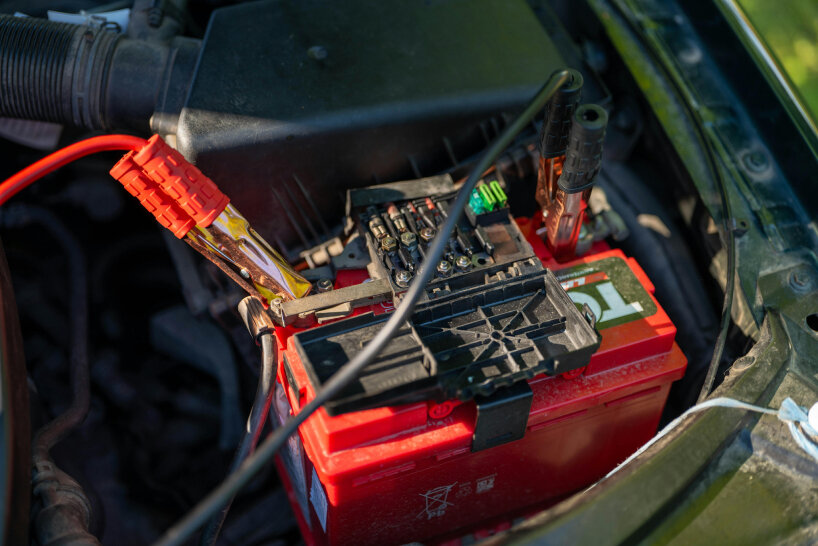used batteries from electric vehicles return to greener life as fertilizers – Designboom

Report on the Innovative Recycling of Electric Vehicle Batteries into Agricultural Fertilizers
Introduction: A Circular Economy Approach to Battery Waste
A research initiative at the University of Wisconsin–Milwaukee has developed a novel method for recycling end-of-life lithium iron phosphate batteries from electric vehicles (EVs) into valuable fertilizers for agricultural use. This innovation directly addresses the growing challenge of EV battery disposal, which typically occurs after a ten-year lifespan. The project aims to create a sustainable and economically viable alternative to conventional recycling methods, which are often cost-prohibitive due to the low market value of recovered materials like iron and phosphate. This approach aligns with the principles of a circular economy, transforming waste into a resource and contributing to multiple Sustainable Development Goals (SDGs).
Technological Process and Methodology
The Ion-Exchange System
The recycling process, led by Dr. Deyang Qu, employs a commercially mature chemical method known as ion exchange (IX). This established technology, commonly used in applications such as water purification, has been adapted to treat used EV batteries. The process involves the following key steps:
- Used battery materials are introduced into an ion-exchange system containing specific resins.
- Two types of resins are utilized: strong acid cation resins and potassium-based (K-form) resins.
- These resins facilitate the replacement of lithium ions in the battery material with hydrogen or potassium ions.
- The ion-exchange and regeneration reactions achieve equilibrium within approximately 20 minutes, demonstrating high process efficiency.
Dual-Benefit Outcome: Resource Recovery and Product Creation
This recycling method yields two distinct and valuable outputs, directly supporting sustainable production models.
- Lithium Recovery: The process efficiently recovers over 90 percent of the lithium, which can then be repurposed for the manufacturing of new batteries.
- Fertilizer Production: The remaining solution, rich in phosphorus and other essential elements from the original battery cathode, is processed into a functional agricultural fertilizer.
Alignment with Sustainable Development Goals (SDGs)
Advancing SDG 12: Responsible Consumption and Production
This initiative is a prime example of advancing SDG 12 by creating a circular production pattern for EV batteries. It mitigates waste generation through prevention, reduction, recycling, and reuse, transforming a potential environmental liability into a valuable input for another industry.
Supporting SDG 2 (Zero Hunger) and SDG 15 (Life on Land)
By converting battery waste into fertilizer, the project contributes directly to sustainable agriculture, a cornerstone of SDG 2. This innovation provides a new source of crop nutrients, potentially enhancing food security. Furthermore, by diverting hazardous battery waste from landfills, the process helps protect and restore terrestrial ecosystems, in line with the objectives of SDG 15.
Fostering SDG 9: Industry, Innovation, and Infrastructure
The research represents a significant technological innovation with the potential for industrial-scale application. As the ion-exchange technology is already commercially mature, the infrastructure for scaling up this process is readily available. This promotes inclusive and sustainable industrialization by creating a new, green industry sector that bridges the automotive and agricultural fields.
Research Status and Future Outlook
From Laboratory to Field Trials
The project has successfully demonstrated its viability at a laboratory scale, with initial support from the University of Wisconsin–Milwaukee’s Discovery and Innovation Grant and in collaboration with the U.S. Department of Agriculture. The primary motivation for the research was to develop a more cost-effective recycling solution by creating a new value chain for battery materials in agriculture.
Pathway to Commercialization
The next phase of the project involves scaling up production to conduct comprehensive agricultural trials. The research team plans to:
- Produce larger quantities of the recycled fertilizer for extensive testing.
- Conduct a one-acre tomato crop trial to compare the performance of the battery-derived fertilizer against conventional commercial fertilizers.
- Present successful trial results to major fertilizer manufacturers to explore large-scale production and commercialization opportunities.
SDGs Addressed in the Article
SDG 2: Zero Hunger
- The article discusses a new method to create “crop and plant fertilizers” from used electric vehicle batteries. This innovation is intended to “help the agriculture industry,” directly contributing to sustainable agricultural practices that are essential for ending hunger and ensuring food security.
SDG 9: Industry, Innovation, and Infrastructure
- The research conducted by engineers at the University of Wisconsin–Milwaukee represents a significant scientific innovation. The article highlights the development of a new, efficient chemical method (“ion exchange”) for recycling, which is described as “commercially mature,” meaning the “equipment and technology already exist and can be scaled up for industrial use.” This aligns with building resilient infrastructure and fostering industrial innovation.
SDG 11: Sustainable Cities and Communities
- The source of the waste discussed is used batteries from electric vehicles, which are increasingly used in urban transport (“EVs, delivery vans, and buses”). Developing effective recycling methods for this waste is crucial for managing the environmental impact of cities and making urban systems more sustainable.
SDG 12: Responsible Consumption and Production
- This is the most central SDG to the article. The entire focus is on moving away from a linear model where used batteries are “just disposed of” to a circular one. The process involves recycling and repurposing waste into valuable new products (recovered lithium and fertilizer), which directly addresses the need to “substantially reduce waste generation through… recycling and reuse.”
Specific SDG Targets Identified
SDG 2: Zero Hunger
- Target 2.4: By 2030, ensure sustainable food production systems and implement resilient agricultural practices. The article’s proposal to turn battery waste into fertilizer supports this target by creating a new, potentially more sustainable source of agricultural inputs, thereby contributing to the resilience and productivity of food systems.
SDG 9: Industry, Innovation, and Infrastructure
- Target 9.4: By 2030, upgrade infrastructure and retrofit industries to make them sustainable, with increased resource-use efficiency and greater adoption of clean and environmentally sound technologies and processes. The ion-exchange recycling method is presented as a more efficient and less costly alternative to traditional methods, representing a cleaner and more sustainable industrial process.
- Target 9.5: Enhance scientific research, upgrade the technological capabilities of industrial sectors. The project, originating from university research and supported by an “internal Discovery and Innovation Grant,” is a direct example of scientific research aimed at creating scalable industrial applications.
SDG 11: Sustainable Cities and Communities
- Target 11.6: By 2030, reduce the adverse per capita environmental impact of cities, including by paying special attention to… municipal and other waste management. The article addresses the growing problem of electronic waste from electric vehicles in urban areas, offering a solution for managing this specific waste stream effectively.
SDG 12: Responsible Consumption and Production
- Target 12.4: By 2020, achieve the environmentally sound management of chemicals and all wastes throughout their life cycle… and significantly reduce their release to… soil. The new recycling process provides a method for the environmentally sound management of battery waste, preventing its disposal in landfills where harmful chemicals could leach into the soil.
- Target 12.5: By 2030, substantially reduce waste generation through prevention, reduction, recycling and reuse. The core theme of the article is recycling used batteries to reduce waste. The process not only recycles materials but also repurposes them for a completely new use in agriculture, embodying the principles of a circular economy.
Indicators for Measuring Progress
Mentioned Indicators
- Lithium Recovery Rate: The article explicitly states that the process allows “more than 90 percent of the lithium to be recovered efficiently.” This is a direct quantitative indicator of the recycling process’s effectiveness.
- Process Efficiency Time: It is mentioned that the “ion-exchange and regeneration reactions can reach balance in as little as 20 minutes,” which serves as an indicator of the method’s speed and efficiency compared to other processes.
Implied Indicators
- Crop Yield Comparison: The plan to “conduct a one-acre tomato crop trial to study how well the fertilizer works” implies an indicator. The progress could be measured by comparing the crop yield, plant health, and soil quality of land using the recycled fertilizer versus land using conventional fertilizers.
- Waste Diversion Rate: An implied indicator would be the percentage or total volume of used electric vehicle batteries diverted from landfills and processed through this recycling method.
- Scalability and Commercial Adoption: The success of presenting “the findings to major fertilizer manufacturers” and achieving “large-scale production” would be a key indicator of the technology’s real-world impact and contribution to the SDGs.
Summary Table of SDGs, Targets, and Indicators
| SDGs | Targets | Indicators |
|---|---|---|
| SDG 2: Zero Hunger | 2.4: Ensure sustainable food production systems and implement resilient agricultural practices. | Performance of the recycled fertilizer in crop trials (e.g., tomato crop yield) compared to conventional fertilizers. |
| SDG 9: Industry, Innovation and Infrastructure | 9.4: Upgrade industries to make them sustainable, with increased resource-use efficiency and greater adoption of clean technologies. 9.5: Enhance scientific research and upgrade technological capabilities. |
Efficiency of the ion-exchange process (reactions balance in 20 minutes); Rate of commercial adoption and scale-up for industrial use. |
| SDG 11: Sustainable Cities and Communities | 11.6: Reduce the adverse per capita environmental impact of cities, including waste management. | Volume/percentage of used EV batteries diverted from urban waste streams and landfills. |
| SDG 12: Responsible Consumption and Production | 12.4: Achieve the environmentally sound management of chemicals and all wastes. 12.5: Substantially reduce waste generation through recycling and reuse. |
Lithium recovery rate (over 90%); Total amount of waste batteries recycled into fertilizer and recovered lithium. |
Source: designboom.com
What is Your Reaction?
 Like
0
Like
0
 Dislike
0
Dislike
0
 Love
0
Love
0
 Funny
0
Funny
0
 Angry
0
Angry
0
 Sad
0
Sad
0
 Wow
0
Wow
0


















































.jpg.webp?itok=0ZsAnae9#)





/environment-climate-change-and-health-(ech)/water-sanitation-hygiene-and-health-(wsh)/landfill-tuvalu-36092.tmb-1200v.jpg?sfvrsn=5c21fe40_1#)



















